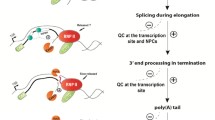The half-life of individual mRNA plays a central role in controlling the level of gene expression. However, the determinants of mRNA stability have not yet been well defined. Most previous studies suggest that mRNA length does not affect its stability. Here, we show significant negative correlations between mRNA length and stability in human and Escherichia coli, but not in Saccharomyces cerevisiae or Bacillus subtilis. This finding suggests the possibility that endonucleolytic attacks by RNA endonuclease and/or mechanical damage may strongly influence mRNA stability in both prokaryotes and eukaryotes.
Similar content being viewed by others
REFERENCES
Bernstein, J. A., Khodursky, A. B., Lin, P. H., Lin-Ghao, S., and Cohen, S. N. (2002). Global analysis of mRNA decay and abundance in Escherichia coli at single-gene resolution using two-color fluorescent DNA microarrays. Proc. Natl. Acad. Sci. U. S. A. 99:9697–9702.
Bernstein, J. A., Lin, P. H., Cohen, S. N., and Lin-Chao, S. (2004). Global analysis of Escherichia coli RNA degradosome function using DNA microarrays. Proc. Natl. Acad. Sci. U. S. A. 101:2758–2763.
Brown, T. A. (2002) Genomes, 2nd edn. John Wiley & Sons, New York.
Dodson, R. E., and Shapiro, D. J. (2002). Regulation of pathways of mRNA destabilization and stabilization. Prog. Nucleic Acid Res. Mol. Biol. 72:129–164.
Doma, M. K., and Parker, R. (2006). Endonucleolytic cleavage of eukaryotic mRNAs with stalls in translation elongation. Nature 440:561–564.
Hambraeus, G., von Wachenfeldt, C., and Hederstedt, L. (2003). Genome-wide survey of mRNA half-lives in Bacillus subtilis identifies extremely stable mRNAs. Mol. Genet. Genomics 269:706– 714.
Herrick, D., Parker, R., and Jacobson, A. (1990). Identification and comparison of stable and unstable messenger-RNAs in Saccharomyces cerevisiae. Mol. Cell. Biol. 10:2269–2284.
Holstege, F. C. P., Jennings, E. G, Wyrick, J. J., Lee, T. I., Hengartner, C. J., Green, M. R., Golub, T. R., Lander, E. S., and Young, R. A. (1998). Dissecting the regulatory circuitry of a eukaryotic genome. Cell 95:717–728.
Jain, C. (2002). Degradation of mRNA in Escherichia coli. IUBMB Life 54:315–321.
Kang, J. H., Kim, S. A., and Hong, K. J. (2006). Induction of TSPI gene expression by heat shock is mediated via an increase in mRNA stability. FEBS Lett 580:510–516.
Khodursky, A. B., and Bernstein, J. A. (2003). Life after transcription: Revisiting the fate of messenger RNA. Trends Genet. 19:113–115.
Knapinska, A. M., Irizarry-Barreto, P., Adusumalli, S., Androulakis, L., and Brewer, G. (2005). Molecular mechanisms regulating mRNA stability: Physiological and pathological significance. Curr. Genomics 6:471–486.
Mata, J., Marguerat, S., and Bahler, A. (2005). Post-transcriptional control of gene expression: A genome-wide perspective. Trends Biochem. Sci. 30:506–514.
Meyer, S., Temme, C., and Wahle, E. (2004). Messenger RNA turnover in eukaryotes: Pathways and enzymes. Crit. Rev. Biochem. Mol. Biol. 39:197–216.
Parker, R., and Song, H. W. (2004). The enzymes and control of eukaryotic mRNA turnover. Nat. Struct. Mol. Biol. 11:121–127.
Patthy, L. (1999). Genome evolution and the evolution of exon-shuffling: A review. Gene 238:103–114.
Patthy L. (2003). Modular assembly of genes and the evolution of new functions. Genetica 118:217–231.
Raghavan, A., Ogilvie, R. L., Reilly, C., Abelson, M. L., Raghavan, S., Vasdewani, J., Krathwohl, M., and Bohjanen, P. R. (2002). Genome-wide analysis of mRNA decay in resting and activated primary human T lymphocytes. Nucleic Acids Res. 30:5529–5538.
Santiago, T. C., Purvis, I. J., Bettany, A. J., and Brown, A. J. (1986). The relationship between mRNA stability and length in Saccharomyces cerevisiae. Nucleic Acids Res. 14:8347–8360.
Selinger, D. W., Saxena, R. M., Cheung, K. J., Church, G. M., and Rosenow, C. (2003). Global RNA half-life analysis in Escherichia coli reveals positional patterns of transcript degradation. Genome Res. 13:216–223.
Shapiro, R. A., Herrick, D., Manrow, R. E., Blinder, D., and Jacobson, A. (1988). Determinants of mRNA stability in Diclyostelium discoideum amoebae: differences in poly(A) tail length, ribosome loading, and mRNA size cannot account for the heterogeneity of mRNA decay rates. Mol. Cell. Biol. 8:1957–1969.
Tollervey, D. (2006). RNA lost in translation. Nature 440:425–426.
Wang, Y. L., Liu, C. L., Storey, J. D., Tibshirani, R. J., Herschlag, D., and Brown, P. O. (2002). Precision and functional specificity in mRNA decay. Proc. Natl. Acad. Sci. U. S. A. 99:5860–5865.
Wilusz, C. J., and Wilusz, J. (2004). Bringing the role of mRNA decay in the control of gene expression into focus. Trends Genet. 20:491–497.
Yamashita, A., Chang, T. C., Yamashita, Y., Zhu, W., Zhong, Z., Chen, C. Y., and Shyu, A. B. (2005). Concerted action of poly(A) nucleases and decapping enzyme in mammalian mRNA turnover. Nat. Struct. Mol. Biol. 12:1054–1063.
Yang, E., van Nimwegen, E., Zavolan, M., Rajewsky, N., Schroeder, M., Magnasco, M., and Darnell, J. E. (2003). Decay rates of human mRNAs: Correlation with functional characteristics and sequence attributes. Genome Res. 13:1863–1872.
ACKNOWLEDGMENTS
We would like to thank an anonymous referee for comments, Dr. L. Hederstedt of Lund University for providing the data of B. subtilis mRNA half-lives, Shu-Wei Li for help in parsing mRNA length, and Lei Zhu for discussion. This work was supported by National Natural Science Foundation of China (Grant No. 30270695) and Beijing Normal University.
Author information
Authors and Affiliations
Corresponding author
Rights and permissions
About this article
Cite this article
Feng, L., Niu, DK. Relationship Between mRNA Stability and Length: An Old Question with a New Twist. Biochem Genet 45, 131–137 (2007). https://doi.org/10.1007/s10528-006-9059-5
Published:
Issue Date:
DOI: https://doi.org/10.1007/s10528-006-9059-5




